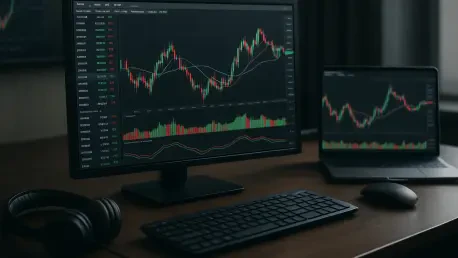The forex trading landscape in Australia is undergoing a profound transformation, driven by the rapid integration of artificial intelligence (AI) into trading systems, marking a significant shift in how traders interact with the Australian Dollar (AUD) and global currency markets. This technology is no longer a futuristic concept but a tangible force reshaping trading practices. AI offers unprecedented capabilities, from analyzing vast datasets in real time to executing trades with pinpoint accuracy, making it a vital tool for both retail and institutional players. In Australia, where the forex market is highly competitive and influenced by unique economic factors, AI is proving to be a game-changer. Local brokers, fintech startups, and seasoned traders are embracing these innovations to gain a competitive edge. This shift is not just about speed or efficiency; it’s about redefining the very nature of trading strategies. As AI becomes deeply embedded in the financial sector, it’s clear that Australian traders are stepping into a new era of opportunity and challenge, one where technology and human insight must work hand in hand.
Transforming the Forex Landscape with AI
The adoption of AI in forex trading has positioned Australia as a leader in financial innovation, with systems that leverage deep learning and predictive analytics to process complex market data. These technologies sift through real-time information—ranging from macroeconomic trends to social media sentiment—to forecast currency price movements with a level of precision that surpasses traditional methods. For traders focusing on AUD pairs, this means decisions can be made faster and with greater confidence, especially in a market known for its rapid fluctuations. Fintech companies and brokers across the country are integrating AI tools into their platforms, ensuring that even novice traders can access sophisticated strategies. This democratization of technology is breaking down barriers, allowing a wider range of participants to engage with the forex market on equal footing with larger institutions, fundamentally altering how trading is conducted in Australia.
Beyond predictive power, AI is driving the surge of algorithmic trading, which automates trade execution based on pre-set criteria, minimizing human error and emotional bias. Australian brokers now offer user-friendly interfaces with features like API access and no-code automation, enabling traders to design custom strategies without needing advanced programming skills. These platforms often include automated bots that monitor markets 24/7 and execute trades at optimal moments, a critical advantage in the fast-paced forex environment. Additionally, sentiment analysis tools powered by AI help traders gauge market mood by scanning news and online chatter, providing deeper insights into potential price shifts. This blend of automation and data-driven decision-making is not just enhancing efficiency but also reshaping the skill set required for successful trading, pushing Australian traders to adapt to a more tech-centric approach in their daily operations.
Tackling the Complexities of AUD Pairs
Trading the Australian Dollar presents distinct challenges due to its strong ties to commodity prices, such as iron ore and coal, which heavily influence its value on the global stage. AI systems are uniquely equipped to handle this complexity by integrating commodity market data with traditional forex indicators, offering traders a more holistic view of potential price movements. For instance, when global demand for Australian exports fluctuates, AI can quickly adjust predictions and strategies to reflect these changes, something human analysis might miss or delay. This capability is especially crucial in a market where split-second decisions can mean the difference between profit and loss, giving traders focusing on AUD pairs a significant advantage through technology that continuously learns and adapts to new patterns.
However, not all aspects of trading AUD pairs are straightforward, even with AI assistance, as issues like liquidity in less-traded pairs such as AUD/NZD or AUD/SGD can lead to slippage during trade execution. AI addresses this by optimizing order execution strategies, ensuring trades are placed at the best possible price points to minimize losses. Yet, these systems are not immune to pitfalls; model drift, where algorithms lose relevance due to outdated data, remains a persistent risk. To counter this, continuous retraining of AI models with fresh market information is essential, particularly in Australia’s dynamic forex environment where economic policies and global events can shift rapidly. Moreover, volatility triggered by Reserve Bank of Australia (RBA) announcements requires AI tools with event-detection capabilities to adjust exposure before major market disruptions occur, highlighting the need for constant vigilance alongside technological reliance.
Regulatory Oversight in an AI-Driven Market
As AI becomes a cornerstone of forex trading in Australia, regulatory bodies like the Australian Securities and Investments Commission (ASIC) are intensifying efforts to safeguard market integrity while fostering innovation. The focus is on ensuring transparency in AI-driven trading systems, particularly regarding how data is used and decisions are made by algorithms. Measures under consideration include mandatory kill switches for high-speed trading algorithms to halt operations during unexpected anomalies, preventing potential market chaos. ASIC’s approach reflects a broader commitment to balancing the benefits of cutting-edge technology with the need to protect investors from systemic risks, ensuring that the rapid adoption of AI does not compromise the stability of Australia’s financial ecosystem in this new era of trading.
Additionally, the regulatory landscape is evolving to address emerging areas like digital assets and tokenized custody, which are increasingly intertwined with AI technologies in forex markets. Australia is exploring comprehensive legislative frameworks that aim to standardize oversight across these innovative fields, creating a unified structure that supports technological advancement without sacrificing accountability. Data security is another critical concern, as AI systems rely on vast amounts of sensitive information that must be protected against breaches or misuse. By prioritizing these elements, regulators are working to build trust among traders and investors, ensuring that the integration of AI into forex trading enhances market efficiency while maintaining robust safeguards against potential downsides that could arise from unchecked automation or inadequate governance.
Practical Strategies for Australian Traders
For traders in Australia aiming to capitalize on AI’s potential in forex trading, adopting a disciplined approach that blends technology with sound judgment is paramount. Starting with simulations such as backtesting allows individuals to test AI-driven strategies in a risk-free environment, refining approaches before deploying real capital. This step is crucial for understanding how algorithms perform under various market conditions, especially in the volatile AUD market influenced by external economic factors. Human oversight remains indispensable, as unexpected events or market anomalies can sometimes outpace even the most advanced AI systems, requiring manual intervention to mitigate risks. Staying informed about global economic trends and RBA policy updates further complements AI tools, ensuring traders are prepared for sudden shifts that could impact their strategies.
Equally important is the implementation of robust risk management practices alongside AI adoption to navigate the complexities of forex trading effectively. Setting stop-loss limits and circuit breakers can protect against significant losses during unpredictable market swings, while choosing brokers regulated by ASIC ensures low-latency execution and transparent operations. Regular updates to AI algorithms with current data are necessary to prevent performance degradation, as outdated models can lead to costly missteps in fast-moving markets. Maintaining auditable records of trades and strategies also helps in evaluating performance and complying with regulatory expectations. By combining these practices with the power of AI, Australian traders can position themselves to thrive in a landscape where technology drives efficiency, provided they remain adaptable to both market changes and evolving best practices in this tech-forward trading environment.
Reflecting on AI’s Impact and Future Steps
Looking back, the integration of AI into Australia’s forex trading sphere marked a pivotal shift, fundamentally altering how market participants approached the Australian Dollar and beyond. The technology delivered unmatched precision in analyzing data and executing trades, empowering traders to navigate complex market dynamics with confidence. Regulatory efforts by ASIC played a vital role in maintaining stability, ensuring that innovation did not come at the expense of investor trust or market integrity. Challenges like model drift and liquidity risks in AUD pairs were met with adaptive strategies, showcasing the resilience of both technology and human oversight in overcoming obstacles.
Moving forward, the focus should be on fostering collaboration between traders, fintech developers, and regulators to refine AI applications further. Exploring advancements in machine learning could enhance predictive accuracy, while standardized guidelines for data security would bolster confidence in AI systems. Australian traders are encouraged to invest in continuous learning about emerging tools and market trends to stay competitive. By building on the foundation laid by AI’s transformative influence, the forex trading community can ensure sustainable growth, leveraging technology to unlock new opportunities while addressing potential risks with proactive solutions.









